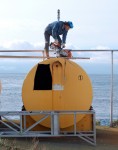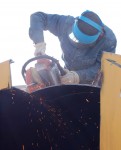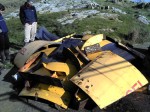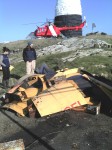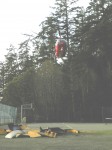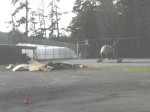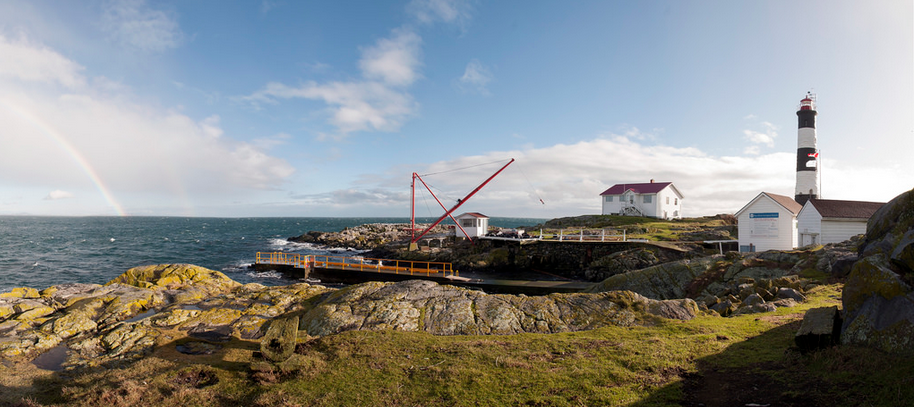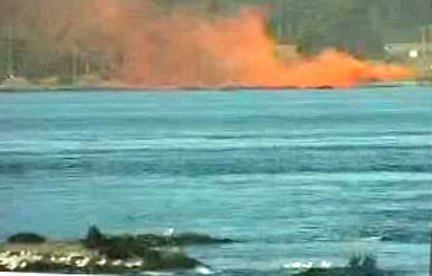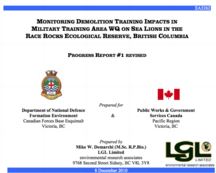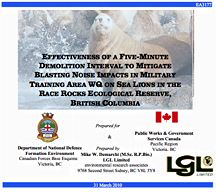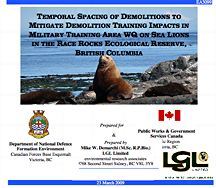‘2011-03-22′, ’11:50:03’, ‘Too Close: — 2 kayaks: Two gentlemen, one wearing orange in a black kayak the other wearing red in a yellow kayak entered the reserve to surf the strong ebb currents. Their course took them within 1m of the rocks, grazing submerged rocks on the E side of Great Race. Their recreational activities disturbed Harlequin ducks (6), Pigeon guillemots (21), and Black Oystercatchers (2) who were foraging in this area., ‘Ryan Murphy’, ’11:53:53.
Category Archives: Admin
Harlequin Ducks put off by DND Blasting
14 Harlequin Ducks have arrived at Race Rocks and are making good use of the fine weather this past week. Unfortunately, these shy birds have been scared away today by bomb blasts on Bentinck Island. Blasting by CFAD Rocky Point has been continuous today with the exception of a lunch break at noon. It is very disappointing that the 5-minute interval designed to minimize DND impact on the ecological reserve has not been observed. Most blasts come in clusters with ~2-minute intervals. The blasting occurring around the time of this report ~13:54 had ~1-minute intervals.
Removal of old diesel oil tank
The oil tanks near the engine room were installed in the early 1990s. With the development of the integrated energy system, and the decrease in the demand for oil, they are now being dismantled. Erik Schauf came out today and cut the first one up. Alex and Virginee helped load the materials and with the help of the Coastguard helicopter, it was transferred to the tennis courts at Pearson College, from where Pearson College transported it to the recycle depot.
- After the first cut
- Eric with a large disc grinder
- Alex and Virginie check the pile
- A pile of metal ready to go
- lowering metal to ground
- On the tennis court ready to be hauled to the recycle depot.
Ryan Murphy’s Photos of Race Rocks
The most impressive pictures taken at Race Rocks are surely those done by Ryan Murphy, a graduate of Lester Pearson College who served as Ecoguardian in 2008-2011.
Ryan’s Flickr site is certainly worth browsing as almost every facet of life at Race Rocks has been covered in very artistic photographic excellence. Check out the several albums on Race Rocks .
Lighthouse team disputes right to sell Race Rocks
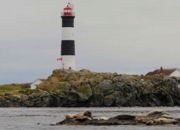 Lighthouse team disputes right to sell Race Rocks operators say beacons not owned by federal government
Lighthouse team disputes right to sell Race Rocks operators say beacons not owned by federal government
BY AMY MINSKY, POSTMEDIA NEWS DECEMBER 24, 2010 
The 150-year-old tower at Race Rocks is among nearly 1,000 lighthouses and light stations under threat.
Photograph by: BRUCE STOTESBURY, Timescolonist.com
OTTAWA — With the federal government preparing to sell almost 1,000 lighthouses across the country, the group overseeing operations at the beacon on Race Rocks, off Vancouver Island, says many are not the government’s to sell.
At issue is who holds the rights to the land — the respective provinces or the federal government.
The lighthouse at Race Rocks, one nautical mile below the southernmost tip of the Island, was built by the Royal Navy in 1860.
It has been listed as “for sale” since June, when the government designated it and the others as surplus property. The tower stands on a rock within an island that is part of a provincial ecological reserve.
While the tower is owned and operated by the Canadian Coast Guard, the land on which it sits is not federal property, a spokesman for the province said Thursday. “The land occupied by the lighthouse on Race Rocks is provincial land, which is under a transfer, or lease, to the federal government for lighthouse purposes,” said Dan Gilmour, a spokesman for B.C.’s environment ministry.
In a letter to the Race Rocks team after the lighthouse was designated surplus property, Gilmour’s colleague, Doug Biffard, said he had received notice from the federal government indicating it was aware of the quandary.
“The Department of Fisheries and Oceans and the coast guard know that they cannot enter into any arrangement to sell, lease or otherwise tenure out, most of the lighthouses in B.C. because the land is under provincial ownership,” the letter said.
Last summer, the federal DFO published a catalogue of 975 surplus properties following the coast guard’s assessment of all the lighthouses it operates.
The list contains at least one from every province except Saskatchewan. To save the lighthouses listed as surplus, a community or group must agree to take on the maintenance of the site, but the federal government would continue to operate and maintain the lighthouse.
The government was criticised when the listing became public in June. Many groups said it undermined the Heritage Lighthouse Protection Act, which had come into force days earlier. The act was designed to ensure the federal government preserved historically significant lighthouses, rather than leave them abandoned.
Those feelings were echoed by the chairman of the Senate committee on fisheries and oceans, Liberal Sen. Bill Rompkey.
This week, the committee released the first of two reports on lighthouses.
When the committee toured the country and hosted discussions on the future of lighthouses, it heard from some of the stakeholders at Race Rocks, including Garry Fletcher, B.C. Parks Ecological reserve warden.
“It would defy logic to see how the federal government could sell a property owned by the province,” Fletcher said.
© Copyright (c) The Victoria Times Colonist
Lighthouse Team Disputes Right to Sell–(Times Colonist)
Race Rocks operators say beacons not owned by federal government
Dec 24, 2010
By Amy Minsky, Postmedia News December 24, 2010
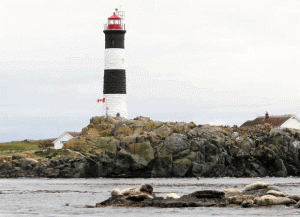 The 150-year-old tower at Race Rocks is among nearly 1,000 lighthouses and light stations under threat.
The 150-year-old tower at Race Rocks is among nearly 1,000 lighthouses and light stations under threat.
Photograph by: Bruce Stotesbury, Timescolonist.com
Ottawa— With the federal government preparing to sell almost 1,000 lighthouses across the country, the group overseeing operations at the beacon on Race Rocks, off Vancouver Island, says many are not the government’s to sell.
At issue is who holds the rights to the land — the respective provinces or the federal government. Continue reading
Boats in the Ecological Reserve Data for 2010
These notes below are taken from the old log of marine vessel occurrence and behaviours while in the reserve in 2010. Only those occurrences observed by the Ecoguardian and recorded at the time are represented here. This does not preclude other boats being in the reserve at other times.
‘2010-01-03’, ‘Eco-Tour’, 1, ‘Company was called as the driver did not observe the Pacific Whale Watch Association guidelines of the go-slow zone that surrounds the rocks and islands of the reserve (i.e. the operator powered up to leave the reserve going East before passing the North-South meridian between North Race and Great Race Island).’, ‘Ryan’, ’14:16:55′),
‘2010-01-17’, ‘Pleasure’, 1, ‘Large black zodiac came from Victoria, reduced speed and kept distance from all rocks. Went through the main channel E->W as far as the sea lions, turned around and left bound for Victoria.’, ‘Ryan’, ’12:35:43′),
‘2010-01-31’, ‘Eco-Tour’, 1, ”, ‘Ryan’, ’16:31:59′),
‘2010-02-15’, ‘Eco-Tour’, 3, ”, ‘Ryan’, ’14:55:48′),
‘2010-03-07’, ‘Eco-Tour’, 4, ‘POW, \\”BC Lung\\”, Eagle Wing, and 1 other’, ‘Ryan’, ’15:51:39′),
‘2010-03-28’, ‘Eco-Tour’, 12, ”, ‘Ryan’, ’16:02:27′),
‘2010-03-31’, ‘Eco-Tour’, 9, ”, ‘Ryan’, ’16:04:22′),
‘2010-03-31’, ‘Other’, 2, ”, ‘Ryan’, ’16:02:53′),
‘2010-04-07’, ‘Eco-Tour’, 5, ”, ‘Ryan’, ’16:15:08′),
, ‘2010-04-11’, ‘Pleasure’, 4, ”, ‘Ryan’, ’15:00:42′),
‘2010-04-11’, ‘Eco-Tour’, 10, ‘A lot of west-bound traffic in the afternoon, I’m guessing there are some whales out past Sooke.’, ‘Ryan’, ’16:09:22′),
‘2010-04-17’, ‘Eco-Tour’, 12, ”, ‘Ryan’, ’22:06:29′),
‘2010-04-23’, ‘Eco-Tour’, 12, ‘a wet old day, but lots of traffic.’, ‘Ryan’, ’18:30:23′),
‘2010-04-24’, ‘Eco-Tour’, 7, ”, ‘Ryan’, ’18:32:55′),
‘2010-04-25’, ‘Eco-Tour’, 10, ”, ‘Ryan’, ’20:08:53′),
‘2010-04-25’, ‘Fishing’, 3, ”, ‘Ryan’, ’20:09:03′),
‘2010-05-02’, ‘Eco-Tour’, 8, ‘Traffic is really beginning to pick up. 3 eco tour zodiacs paraded past the jetty today in under 60 seconds.’, ‘Ryan’, ’15:55:24′),
‘2010-05-13’, ‘Eco-Tour’, 25, ‘A busy day in the reserve today, however the tours have been regularly spaced so that the traffic congestion seen here in the fall has not materialized.’, ‘Ryan’, ’16:26:02′),
‘2010-05-21’, ‘Pleasure’, 4, ‘safe/slow tours of the reserve conducted by all, with illegal fishing thrown in.’, ‘Ryan’, ’15:52:31′),
‘2010-05-21’, ‘Eco-Tour’, 17, ‘traffic is definitely picking up.’, ‘Ryan’, ’15:52:46′),
‘2010-05-22’, ‘Pleasure’, 5, ‘Had to call 2 boats who were speeding through the turbine area, but luckily they listen to their radios.’, ‘Ryan’, ’15:53:18′),
‘2010-05-22’, ‘Eco-Tour’, 31, ‘A lot of traffic today, including a troubling increase in the < 50m viewing distance of marine mammals and increased maneuvering of boats to do so on the N side of Great Race.’, ‘Ryan’, ’15:54:34′),
‘2010-05-29’, ‘Other’, 1, ‘First Swiftsure boat made it to Race Passage at 11:15’, ‘Ryan’, ’11:07:04′),
‘2010-06-11’, ‘Eco-Tour’, 5, ”, ‘adam’, ’21:07:37′),
‘2010-06-12’, ‘Eco-Tour’, 20, ”, ‘adam’, ’20:28:03′),
‘2010-06-12’, ‘Pleasure’, 5, ”, ‘adam’, ’20:28:17′),
‘2010-06-21’, ‘Eco-Tour’, 3, ”, ‘adam’, ’18:17:34′),
‘2010-06-21’, ‘Pleasure’, 1, ”, ‘adam’, ’18:17:41′),
‘2010-06-27’, ‘Eco-Tour’, 1, ”, ‘adam’, ’18:18:09′),
‘2010-06-27’, ‘Pleasure’, 2, ‘One pleasure vessel this afternoon approached far too close to Middle Rock and scared all the seals away. I tried to hail them on the radio but only had silence.’, ‘adam’, ’18:18:59′),
‘2010-07-02’, ‘Pleasure’, 12, ”, ‘adam’, ’19:14:31′),
‘2010-07-03’, ‘Eco-Tour’, 25, ”, ‘adam’, ’14:54:02′),
‘2010-07-03’, ‘Fishing’, 1, ”, ‘adam’, ’14:54:08′),
‘2010-07-04’, ‘Fishing’, 1, ”, ‘adam’, ’21:37:15′),
‘2010-07-06’, ‘Pleasure’, 15, ”, ‘adam’, ’20:08:09′),
‘2010-07-06’, ‘Fishing’, 3, ”, ‘adam’, ’20:08:15′),
‘2010-07-06’, ‘Eco-Tour’, 20, ”, ‘adam’, ’20:08:23′),
‘2010-07-16’, ‘Pleasure’, 1, ”, ‘adam’, ’09:17:17′),
‘2010-07-16’, ‘Eco-Tour’, 15, ”, ‘adam’, ’09:17:23′),
‘2010-07-17’, ‘Eco-Tour’, 35, ”, ‘adam’, ’22:03:19′),
‘2010-07-17’, ‘Pleasure’, 2, ”, ‘adam’, ’22:03:29′),
‘2010-07-17’, ‘Diving’, 1, ”, ‘adam’, ’22:03:35′),
‘2010-08-08’, ‘Eco-Tour’, 40, ”, ‘adam’, ’09:41:23′),
‘2010-08-13’, ‘Eco-Tour’, 40, ”, ‘adam’, ’07:09:11′),
‘2010-08-24’, ‘Pleasure’, 2, ”, ‘adam’, ’10:21:27′),
‘2010-08-24’, ‘Fishing’, 3, ”, ‘adam’, ’10:21:34′),
‘2010-08-24’, ‘Eco-Tour’, 25, ”, ‘adam’, ’10:21:47′),
‘2010-09-04’, ‘Kayak’, 7, ‘See disturbance report’, ‘Ryan’, ’16:32:23′),
‘2010-09-04’, ‘Eco-Tour’, 5, ”, ‘Ryan’, ’16:32:33′),
, ‘2010-09-15’, ‘Eco-Tour’, 2, ‘I share here a typical example of the interaction of Eco Tour vessels and the wildlife at Race Rocks. This occurred from 10:50 to 11:05 this morning: A Seafun Safaris boat entered the reserve first and maintained a respectable distance from marine mammals while making a passive drift tour of the sea lions hauled out on Great Race Island. The driver obviously is aware of and believes in the importance of the PWWA’s stewardship protocols for viewing wildlife at Race Rocks.\r\nThe Eagle Wing Tours vessel Gold Wing entered the reserve and approached the Seafun Safaris vessel motoring against the current. Its noisy, active approach alerted the Steller sea lions on the NE corner of Great Race Island causing some individuals to take to the water. The Seafun Safaris vessel finished its drift tour and left the reserve after a respectful and sustainable tour. The Eagle Wing Tours vessel drifted and motored against the current several more times while viewing the sea lions on Great Race Island before motoring further against the current to view the sea lions on Middle Rocks. Sound and traffic congestion in the narrow channels are concerns for both Ecological Reserve management and community stakeholders. All vessels are reminded that passive drift tours are encouraged “whenever possible “, particularly in conditions of rippled seas as we are enjoying today.’, ‘Ryan’, ’11:08:22′),
‘2010-09-21’, ‘Eco-Tour’, 26, ”, ‘Ryan’, ’19:02:12′),
‘2010-11-05’, ‘Eco-Tour’, 1, ”, ‘VirginieLP’, ’09:09:41′),
‘2010-11-06’, ‘Diving’, 2, ‘Divers in two locations, arrived around 11:00 and departed around 14:00.’, ‘VirginieLP’, ’09:07:39′),
‘2010-11-06’, ‘Eco-Tour’, 1, ‘Eagle wing whale watching tour stopped by at 16:30.’, ‘VirginieLP’, ’09:08:33′),
‘2010-11-07’, ‘Eco-Tour’, 2, ‘Prince of Whales at 2:50\r\nSprint tide at 11:30’, ‘VirginieLP’, ’08:14:53′),
‘2010-11-07’, ‘Other’, 0, ‘3 private vessels came through the reserve’, ‘VirginieLP’, ’08:16:35′),
‘2010-11-08’, ‘Eco-Tour’, 2, ‘whale watching tours-orange boats (missed the name of company)’, ‘VirginieLP’, ’23:02:22′),
‘2010-11-11’, ‘Eco-Tour’, 2, ‘Prince of Whales at 13:50\r\nUnidentified tour boat at 16:30’, ‘VirginieLP’, ’22:57:21′),
‘2010-11-12’, ‘Eco-Tour’, 3, ‘Eagle Wing tours at 14:30, Prince of Whales at 15:30, Seaking Adventures at 16:00.’, ‘VirginieLP’, ’15:57:12′),
‘2010-11-16’, ‘Eco-Tour’, 1, ‘Eagle wing around 15:00’, ‘VirginieLP’, ’11:50:50′),
‘2010-11-18’, ‘Eco-Tour’, 1, ‘prince of whales @ 16:00’, ‘VirginieLP’, ’18:54:35′),
‘2010-11-21’, ‘Eco-Tour’, 1, ‘whale watching boat’, ‘VirginieLP’, ’20:26:19′),
‘2010-11-27’, ‘Diving’, 2, ‘in the morning, Ogden point diving boats’, ‘AlexF’, ’18:54:05′),
‘2010-11-27’, ‘Eco-Tour’, 1, ‘around 15:00, orange zodiac.’, ‘AlexF’, ’19:02:15′),
‘2010-11-28’, ‘Eco-Tour’, 1, ‘Eagle Wing, caused some upset to the sea lions on west rock’, ‘AlexF’, ’09:18:11′),
‘2010-11-28’, ‘Fishing’, 1, ”, ‘AlexF’, ’09:18:49′),
‘2010-12-06’, ‘Eco-Tour’, 1, ‘Zodia with a cabin, \\”BC Luna\\”, passed through reserve.’, ‘AlexF’, ’09:17:10′),
‘2010-12-19’, ‘Eco-Tour’, 1, ‘princess of whales 14:30’, ‘AlexF’, ’19:59:44′),
Military Activities Near Race Rocks
DND BLASTING ACTIVITIES AT ROCKY POINT:
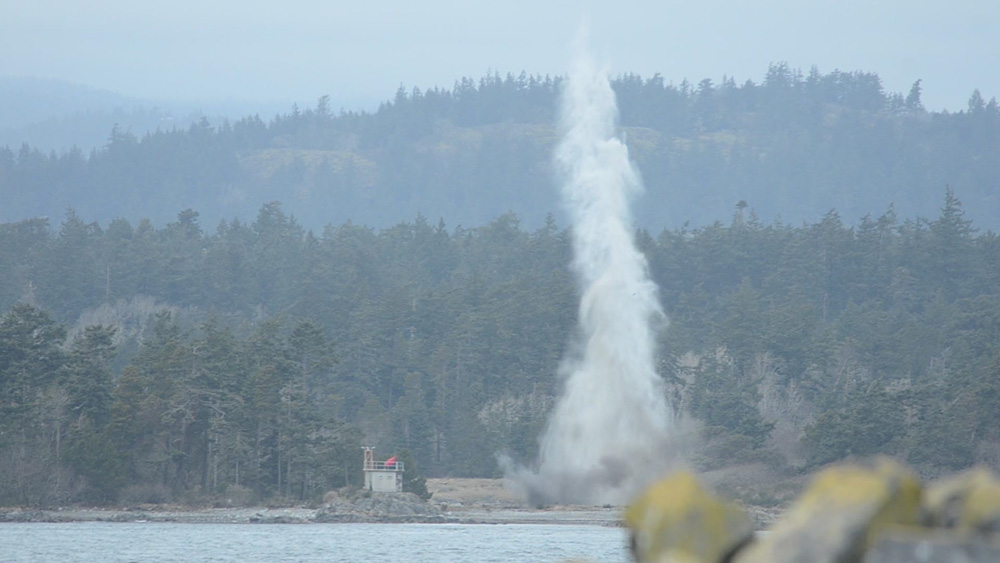 Bentinck island is used by the Department of National Defense as both a demolition range and a testing range for explosives. On the South end of Rocky Point there is a disposal pit where other demolition occurs, and in Whirl Bay, behind Christopher Point, there is an underwater test site. The size of the explosions is supposed to be monitored and controlled , however, we invariable get widely varying impacts. Our ecoguardians have made observations of the impact on sea
Bentinck island is used by the Department of National Defense as both a demolition range and a testing range for explosives. On the South end of Rocky Point there is a disposal pit where other demolition occurs, and in Whirl Bay, behind Christopher Point, there is an underwater test site. The size of the explosions is supposed to be monitored and controlled , however, we invariable get widely varying impacts. Our ecoguardians have made observations of the impact on sea
lions, seals and seabirds over the last few years. Invariably the blasting results in the sea lions being scared from the islands . Sometimes they do come back to haul out on the rocks but they often move on to another location. Unfortunately the location of Race Rocks next to these areas makes it very difficult to mitigate the impact of these explosions.
- See the “Before and After” from the sitezap camera 1- Nov 7,2002
- Link to Fisheries and Oceans Canada file on Guidelines for the Use of Explosives In or Near Canadian Fisheries Waters
- The Race Rocks logs have documented the activities of the military and the effects observed on the animals of Race Rocks
- Summary report: Responses of Steller Sea Lions (Eumetopias jubatus) to In-Air Blast Noise from Military Explosions DEMARCHI, MW AND MD BENTLEY. 2004.
- Effects of natural and human-caused disturbances on marine birds and pinnipeds at Race Rocks, British Columbia. LGL Report EA1569. Prepared for Department of National Defence, Canadian Forces Base Esquimalt and Public Works and Government Services Canada. 103 p.
- This video was made on October 7, 2002 in order to document the effect of the
 Department of National Defence demolition exercises on Bentinck Island on the behaviour of birds and marine mammals at Race Rocks MPA. In previous years we have observed considerable disruption by military exercises involving blasting on nearby Bentinck Island in the fall just after the sea lions have returned to the island. We have requested that blasts be spread out over a longer period of time during an exercise. Traditionally blasts have come in a series of three. The first one would alert the sea lions, the second would send a few in the water and the third would clear the islands. This year on this one occasion, only two blasts were held at five minutes apart. The results are shown in the video.
Department of National Defence demolition exercises on Bentinck Island on the behaviour of birds and marine mammals at Race Rocks MPA. In previous years we have observed considerable disruption by military exercises involving blasting on nearby Bentinck Island in the fall just after the sea lions have returned to the island. We have requested that blasts be spread out over a longer period of time during an exercise. Traditionally blasts have come in a series of three. The first one would alert the sea lions, the second would send a few in the water and the third would clear the islands. This year on this one occasion, only two blasts were held at five minutes apart. The results are shown in the video. - On November 7, 2002, the DND were still doing their demolition blasting exercises at Bentinck Island. (not Oct 7 as stated in this draft version of the video) The students
 from Lester Pearson College who were out for a project week were able to catch the images of the impact of these blasts on the first day from the science centre window and on the second day from the top of the light tower. In the tower, they interviewed Mike Demarchi of LGL who is currently doing a $50,000 contract for the Department of National Defence to monitor the impact of these blasts and to compare them with other disturbances at Race Rocks.
from Lester Pearson College who were out for a project week were able to catch the images of the impact of these blasts on the first day from the science centre window and on the second day from the top of the light tower. In the tower, they interviewed Mike Demarchi of LGL who is currently doing a $50,000 contract for the Department of National Defence to monitor the impact of these blasts and to compare them with other disturbances at Race Rocks.
Update 2020: and its still going on —-https://www.racerocks.ca/tag/blasting/
and on January 27-2020: another set of blasts from Bentinck Island clears the docks of sealions:
https://www.racerocks.ca/wp-content/uploads/2020/01/Blasting.mp4“][/video]
| Recommendations:
1. Explosions should only be conducted at times of the year when there are no nesting birds or harbour and elephant seals having young . 2. During the months of August, September and October when the sea lions are returning to the islands, they are particularly sensitive to disturbances. 3. December, March and April are probably the times of least impact but only if explosion size is carefully controlled. 4. The sizes of explosions should be carefully monitored so as to limit the impact of disturbance. 5. Blasts should be spaced out to at least 10 minutes between detonation, and especially never three blasts in succession. This lessens the impacts on the animals. SAMPLE DAILY LOGS FROM RACE ROCKS WITH EFFECTS OF BLASTING ON ANIMAL BEHAVIOUR Thursday, November 22, 2001–MARINE LIFE: A typical November day weather wise however the Military detonation exercises on Bentinck Island were particularly disturbing for the Harbour Seals and Sea Lions. Once the blasting was done for the day the animals were still quite nervous and in fact when a Cuda Marine Whale Watching boat went by one rock (15:15-15:30) with approximately 120 sea lions hauled out over half of them stampeded into the water!” Thursday, January 17, 2002 Friday, January 18, 2002 Thursday, January 24, 2002 Addendum: |
| UPDATE: January, 2007: Recent blasting activities at Bentinck Island have flushed some of the birds and have scared some of the northern sea lions into the water. In general however we have observed that when they only do two blasts at more than a 1 minute interval, there is much less disturbance than three successive blasts. |
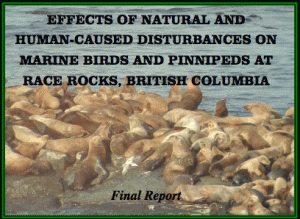 DEMARCHI, MW AND MD BENTLEY. 2004. Effects of natural and human-caused disturbances on marine birds and pinnipeds at Race Rocks, British Columbia. LGL Report EA1569. Prepared for Department of National Defence, Canadian Forces Base Esquimalt and Public Works and Government Services Canada. 103 p. DEMARCHI, MW AND MD BENTLEY. 2004. Effects of natural and human-caused disturbances on marine birds and pinnipeds at Race Rocks, British Columbia. LGL Report EA1569. Prepared for Department of National Defence, Canadian Forces Base Esquimalt and Public Works and Government Services Canada. 103 p.
Note in particular, the discussion of the results concerning the effects of blasting on the behaviour of sea lions.
|
Values Input table from Lester Pearson College UWC 2010
VALUES INPUT TABLE: for DFO Race Rocks MPA Advisory Board Process.
Past, Present, Future Use
Lester B.Pearson College’s first significant interaction with the area was in 1977 as a location for marine biology field trips and diving. Faculty and students initiated the process of getting it preserved as an ecological reserve in 1979:
http://www.racerocks.com/racerock/history/rrerhist.htm
and assisted BC Parks in the preparation of the Management plan.
http://www.env.gov.bc.ca/bcparks/planning/mgmtplns/race_rocks/racerock.html
Since that time there has been a continuous record of student, faculty and staff involvement in doing ecological monitoring in the reserve and in student and visitor field trips,
http://www.racerocks.com/racerock/education/education.htm
From the 2005 report on State of Ecological Reserves in BC, ” For the past several years the Ministry has regularly stated that it is committed to shared stewardship and partnerships. Such a commitment by the Ministry requires innovative approaches and resources. The Race Rocks Ecological Reserve is clearly exemplary from a shared stewardship, ecological protection, public education and applied research perspective.”
http://www.ecoreserves.bc.ca/newsissues_files/State%20of%20Ecological%20Reserves%202005%20final.pdf
Pearson College has supported student research at Rocks ,
http://www.racerocks.com/racerock/research/research.htm
and the faculty and students have assisted outside scientists in research projects there.
http://www.racerocks.com/racerock/research/researchexternal.htm
Each year it provides boat cover for the Christmas Bird Count by the Victoria Natural History Society.
http://www.racerocks.com/racerock/seabirds/xmascount/birdcount.htm
A college faculty member, now retired has continued to serve as Ecological Reserve warden for BC Parks since 1980. and in 1997, the college took over full time management of the Ecological Reserve and the island facilities on a long term lease from BC Parks.
http://www.racerocks.com/racerock/admin/admin.htm
Lester Pearson College has a high level of participation in R&D and energy projects such as the AXYS wind resource assessment buoy testing
https://racerocks.ca/racerock/data/axystest/jdfwindwave.htm
and the Integrated Energy Project involving solar and tidal energy for the Island. http://www.racerocks.com/racerock/energy/tidalenergy/tidalenergy.htm
There is an ongoing program of retrofitting and enhancement of efficiency to the infrastructure through additional solar panel installations; LED and CFL lighting and battery energy storage has resulted in close to 60 % reduction in fuel consumption and resulting emissions.
It has also implemented more efficient water systems and is currently upgrading the composting toilets…
The college has also had an ongoing ecological restoration program for the island in an attempt to mitigate ecological footprint of former operations on the island.
http://www.racerocks.com/racerock/eco/ecorestore.htm
It has installed and continues to run a weather station:
https://racerocks.ca/racerock/data/weatherlink/Current_Vantage_Pro.htm
and continues the long term daily water temperature and salinity records for monthly submission to IOS.
http://www.racerocks.com/racerock/abiotic/temperature/seatemperature.htm
A database is maintained with observations from the ecoguardian and volunteers using remote cameras on tagged and branded marine mammals;
http://www.racerocks.com/racerock/marmam/sealion/tracking/tracking.htm
In 2000, Pearson College secured a grant from the Millennium foundation for the installation of a LAN on the island and internet connection passing live remote controlled video and audio to the outside world by microwave.
http://www.racerocks.com/racerock/video5.htm
The college supports the website racerocks.com which is a non-commercial educational site continually being updated by a volunteer with contributions from staff, students, faculty and outside researchers. This website is used worldwide as a distance education tool, with several specific curriculum programs using the resources contained on the website.
http://www.racerocks.com/racerock/eco/ecoeducation.htm
Ecological features of importance:
The high currents in the area with nutrient laden water lead to a highly productive ecosystem with high biodiversity of Invertebrates, fish and marine algae.
It is a seabird nesting colony for four species, a migratory stopover for countless migrants and overwintering residence for several thousand gulls of several species. It also provides habitat for several species of endangered and listed plants and animals.
It is the largest marine mammal haulout and birthing colony on southern Vancouver Island and a Northern Elephant seal birthing colony,
http://www.racerocks.com/racerock/eco/taxalab/nufar.htm
a harbour seal birthing colony,
http://www.racerocks.com/racerock/eco/taxalab/damionw.htm
a haulout for a large colony of Northern ( Steller’s) sea lion from August to April,
http://www.racerocks.com/racerock/eco/taxalab/nufar.htm
and a haulout for a large colony of California sea lions especially Sept. to December each year.
http://www.racerocks.com/racerock/eco/taxalab/carolinem.htm
The college has supported research on hydroids by Dr. Anita Brinckmann-Voss leading to the identification of over 65 species of that group of cnidarians, several which are new species records.
http://www.racerocks.com/racerock/hydroid/anitabv.htm
In the racerocks.com taxonomy files, an inventory featuring all individual species from the island is continually being updated as new photographs, videos and observations are available.
http://www.racerocks.com/racerock/eco/taxalab/taxonomy.htm
A large bank of video archives also forms a core of the documentation of animals and events on the island,
http://www.racerocks.com/racerock/archives.htm
and the Daily Log section provides a record of daily happenings on the island from the viewpoint of the resident ecoguardian, a monthly photo gallery provided by a viewer using the remote camera, and a log of updates to the website of resources for Race Rocks.
http://www.racerocks.com/racerock/diary/
Geographic features of importance
The archipelago of islands is a unique geographic feature providing optimal exposure in the Strait of Juan de Fuca to diverse elements of wind and currents which lead to a highly biodiverse ecosystem. Its location provides the highest measured upwelling area of the west coast which results in deep water species occurring at a shallow depth and a large biomass of contributed larvae and planktonic species.
The geology:
http://www.racerocks.com/racerock/abiotic/geology/geology.htm
and other physical factors of the area are unique as well and provide a special set of habitats to a large number of species.
http://www.racerocks.com/racerock/eco/ecodata.htm
It is also the most southerly point of Canada on the Pacific Coast.
Cultural features of importance
The island has a historic light station and has hosted generations of pioneering light keeper families who survived under difficult conditions. A year from now, in December 2010, the light tower marks its 150th year as a guiding beacon for those plying the waters of the Strait of Juan de Fuca.
http://www.racerocks.com/racerock/history/histam.htm
In recent years, our investigations on the rock mounds on the island have led them to be identified as pre-contact First Nations burial mounds from a culture that thrived in the area from 1000 to 1500 years ago, and then disappeared . In the year 2000 with the assistance of a First Nations elder, we sought the place name for Race Rocks from a another elder, the late Tom Charles , and were granted permission then to use the Klallum name Xwayen, the area of swift flowing water. Race Rocks is essentially in the geographic centre of the Salish Sea. The first peoples of that sea recognized the close relationship between the land and the sea and we have always dedicated on the home page of racerocks.com, an icon which changes with the 13 stages of he moon as recognized by that culture.
http://www.racerocks.com/racerock/firstnations/first.htm
Human Threats to any of the important features.
The human presence at Race Rocks is a critical component to making this endeavour a success on many levels whether it be safety ; ecological stewardship and restoration; science, education and research; human activities monitoring. As such, adequate funding levels must be maintained to a level that will enable these essential activities to continue. To date, Pearson College has been solely responsible for finding the necessary funds to continue operations. It is important that appropriate funding be secured to enable long term sustainability.
There has been a continuation of problematic recreational boaters who view and disturb animals and birds from too close a distance and increase the chance of boat strikes on marine mammals and diving birds. There continues to be on an intermittent basis recreational fishing in the reserve.
There is ongoing concern for boat traffic, noise and effluent that goes with it, speed reduction and viewing distance. Airline overflights continue to cause occasional disruption to the mammal and bird colonies. The implementation of the DFO regulations on Marine wildlife viewing are long overdue. http://www.racerocks.com/racerock/admin/disturbances.htm
The threat of an oil or chemical spill is always possible in the Strait of Juan de Fuca. This would be heightened if there is an increase in Juan de Fuca Tanker Traffic and removal of the moratorium on offshore drilling. The disposal of wastes and bilge water from all ships and the increasing onset of Cruise lines operating in the area is a real concern.
http://www.racerocks.com/racerock/admin/ships.htm
The rockfish protection area should be maintained and strengthened so that threats to marine mammals are reduced and stock recovery in the area is enhanced.
Other threats to the area
The human presence at Race Rocks is a critical component to making this endeavour a success on many levels whether it be safety, security, ecological stewardship and restoration, education and scientific research, or monitoring of human activities. As such, funding levels must be maintained to a level that will enable these essential activities to be sustainable. To date, Lester Pearson College has been almost solely responsible for finding the necessary funds to continue operations. It is important that appropriate funding be secured to enable long term sustainability.
A general statement of your vision for the area
Pearson College has provided internet linkage to the resources of the island since 2000. Since it is a small area with a complex set of ecosystems, it is our hope that direct human contact remains minimal, while global access to the resources through the internet remains high.
The commitment of volunteers, faculty, staff and students of Pearson College over the last 30 years in assembling the resources of Race Rocks and then making them available on racerocks.com and racerocks.ca is evidence of how we value maintaining the ecological integrity of the reserve, and wish to continue sharing it with the world. We plan to continue to support the activities and programs currently underway; improve on them and support new activities and endeavours that will add to our understanding and continued protection of the ecosystem.
The College is committed to explore and expand its research and education opportunities available at RR and maintain a long term presence as the custodian of the Ecological Reserve. It will continue to demonstrate the use and integration of sustainable resources and renewable energy with the goal to reduce the emissions from our operations to an absolute minimum.
Since de-staffing of the station by the Coast Guard in 1997, Lester B. Pearson College has hired Ecoguardian staff to be resident on Race Rocks and has raised over $1 million for operating costs at Race Rocks in the past 12 years of operation. Pearson College will continue to employ staff as Ecoguardians and station operators year round. Currently a full time resident marine scientist holds this position.
Why is the Area important to you?
It is important because ultimately it must be possible for all who pass through this part of the Salish Sea must be informed of its unique values and must be committed to allow it to remain a relatively pristine and undisturbed ecosystem. The significant education and research value can endure if Race Rocks Marine Protected area is well supported and locally managed.
Monitoring Demolition Training Impacts in Military Training area WQ on Sea lions
MONITORING DEMOLITION TRAINING IMPACTS IN
MILITARY TRAINING AREA WQ ON SEA LIONS IN THE
RACE ROCKS ECOLOGICAL RESERVE, BRITISH COLUMBIA
PROGRESS REPORT #1 REVISEDOVERVIEW1
LGL Limited successfully completed 5 days of monitoring (28P30 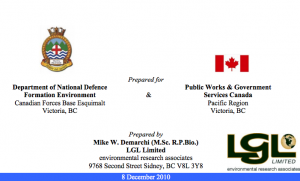 November and 1P2 December 2010) of demolition training (OfficerTs Course) in Exercise and Training area WQ. Monitoring comprised a day of pre-blasting, 3 days with blasting, and a day of post-blasting. We have not yet reviewed information on the sizes of the projects that were detonated, but expect that all were 4 slabs of C4 as per past courses. Projects within a run were spaced at a minimum interval of 5 min. Time between runs varied considerably (~0.4P3.2 hrs). All other ranges in WQ were inactive during monitoring. Weather was modestly overcast and unsettled. Although a gale warning was in effect for local waters during the first few days of the session, winds only reached 20 knots on one day (30 November); they were mostly below 10 knots for the session. Light rain fell at times, and swell height was moderate and high for most of the session. Seas were Beaufort 1P3. Air temperature ranged from 5P8 °C. As per the table below, numbers of sea lions fluctuated considerably within and between days in response to natural and human-caused disturbances. There were no California sea lions in the Reserve and only 1 northern elephant seal. Significant displacement of sea lions from a haulout was observed in response to a single ecotour boat on the pre-blasting day and in response to blasting on days when the range was active. Only one ecotour boat was observed during the 5-day session, but that boat caused a disturbance that saw all sea lions become active (heads up) and most (~100) animals scramble off the haulout. Steller sea lion response to blasting ranged
November and 1P2 December 2010) of demolition training (OfficerTs Course) in Exercise and Training area WQ. Monitoring comprised a day of pre-blasting, 3 days with blasting, and a day of post-blasting. We have not yet reviewed information on the sizes of the projects that were detonated, but expect that all were 4 slabs of C4 as per past courses. Projects within a run were spaced at a minimum interval of 5 min. Time between runs varied considerably (~0.4P3.2 hrs). All other ranges in WQ were inactive during monitoring. Weather was modestly overcast and unsettled. Although a gale warning was in effect for local waters during the first few days of the session, winds only reached 20 knots on one day (30 November); they were mostly below 10 knots for the session. Light rain fell at times, and swell height was moderate and high for most of the session. Seas were Beaufort 1P3. Air temperature ranged from 5P8 °C. As per the table below, numbers of sea lions fluctuated considerably within and between days in response to natural and human-caused disturbances. There were no California sea lions in the Reserve and only 1 northern elephant seal. Significant displacement of sea lions from a haulout was observed in response to a single ecotour boat on the pre-blasting day and in response to blasting on days when the range was active. Only one ecotour boat was observed during the 5-day session, but that boat caused a disturbance that saw all sea lions become active (heads up) and most (~100) animals scramble off the haulout. Steller sea lion response to blasting ranged
from modest increases in activity to complete haulout abandonment. The number of sea lions hauled out in the Reserve at the end of the session (i.e., at the end of the post-blast monitoring day) was practically identical to the number at the beginning of the session (i.e., 130 cf. 131).
The total at the end of the session was off by a modest 20 animals from the peak count during activity samples (i.e., 150) P a difference that could be accounted for by animals not in view from the tower at their new location atop Area 2P5 at the end of the session and animals
swimming near the haulouts. Although nearly all animals were on haulout Area 2P5 at the beginning and end of the session, they had shifted their position to the highest part of the haulout in response to large swells that inundated the lower reaches of the haulout. As of 7 December,
the upper reaches of Area 2P5 continued to be used by most of the sea lions in the Reserve (as evident from the LBPC web cam).
No further monitoring is anticipated until summer/fall 2011.
See the of the full report at lgl2010progreport.
See other LGL reports at:
http://www.racerocks.com/racerock/research/LGL_report/DNDreportbyLGL.htm


